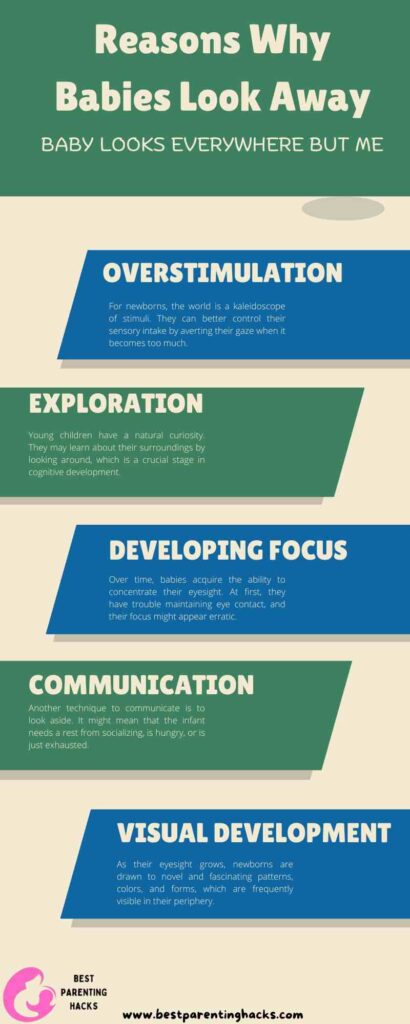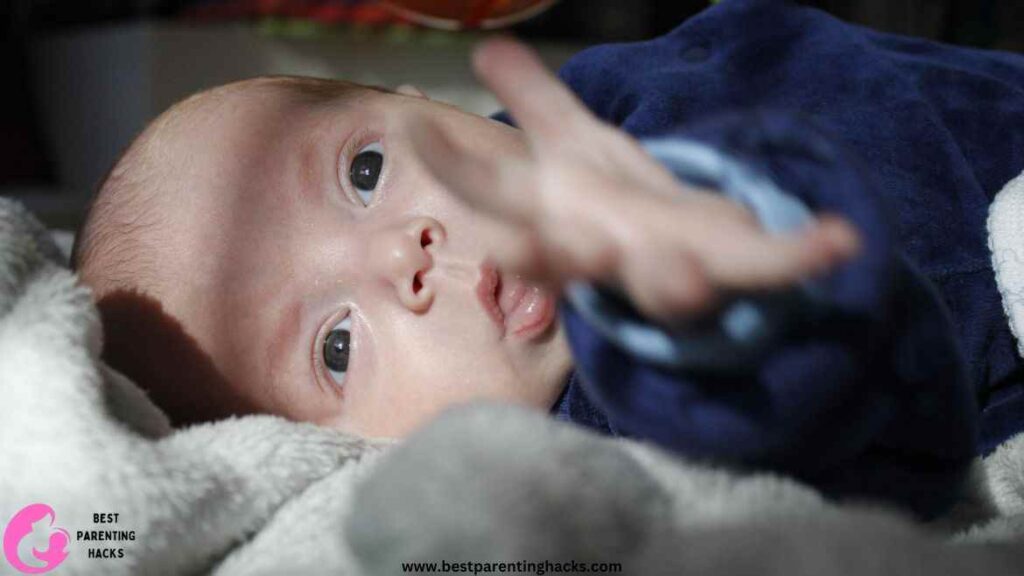Table of Contents
Witnessing the sparkle in your child’s eyes and feeling a connection is truly one of the most enchanting moments, for any parent. The reality of an infant, whose look seems to travel everywhere but into their parent’s eyes, frequently contrasts with this idealized picture. This situation is not unique; in fact, it is a typical one that many parents—including myself—experience. It prompts queries and occasionally worries: Why is my infant staring at everyone else but me? Is this typical? Examining the intriguing realm of newborn development is necessary to comprehend this behavior since each look—or lack thereof—marks a milestone in the development process.
It’s important to understand that a baby’s wandering gaze is a normal aspect of their developing process rather than a sign of rejection while attempting to address the subject at hand. Infants spend their first few months of life adjusting to their new surroundings, which are full of stimulation. Their occasional shifts, in attention, indicate development as they improve their skills in engaging with and exploring their surroundings. Therefore, keep in mind that your kid is developing while they glance everywhere but at you.

Reasons Why Babies Look Away
A baby’s propensity to avert their gaze instead of making eye contact can be explained by many factors:
1. Overstimulation: For newborns, the world is a kaleidoscope of stimuli. They can better control their sensory intake by averting their gaze when it becomes too much.
2. Exploration: Young children have a natural curiosity. They may learn about their surroundings by looking around, which is a crucial stage in cognitive development.
3. Developing Focus: Over time, babies acquire the ability to concentrate their eyesight. At first, they have trouble maintaining eye contact, and their focus might appear erratic.
4. Communication: Another technique to communicate is to look aside. It might mean that the infant needs a rest from socializing, is hungry, or is just exhausted.
5. Visual Development: As their eyesight grows, newborns are drawn to novel and fascinating patterns, colors, and forms, which are frequently visible in their periphery.
You Might Also Like to Read: How Many Baby Washcloths Do I Need?
Understanding Baby’s Vision Development
The ability to see is not the same in babies as it is in adults. During the first several months of life, their eyesight significantly develops. A newborn’s attention range is initially only 8 to 12 inches, which is barely enough to view the face of the person holding them. This results in very hazy eyesight. The limited scope is crucial, during the bonding phase allowing the baby to recognize and establish connections, with its caregivers.
Their capacity to see becomes more acute as they become older, and they get better at recognizing color and depth. There are several phases to this development:
1. Newborn Stage (0–1 month): Infants have limited color vision but can perceive faces and patterns with great contrast up close. Making simple visual associations is the goal of this stage.
2. One to Two Months: The synchronization between the eyes has improved noticeably. Babies begin to follow moving things and exhibit a color and facial preference.
3. Two to Four Months: Perception of depth starts to evolve. Babies begin to reach out for things, demonstrating an increased ability to evaluate distances.
4. Four to Six Months: At this point, color vision resembles that of an adult. Infants can see across the room, but not as well as adults and older children.
You Might Also Like to Read: Where to Store Baby Bottles After Sterilizing?

The Role of Eye Contact in Bonding
Making eye contact with a newborn helps parents and children emotionally bond, and it goes beyond just a visual exchange. A baby’s nonverbal communication when they make eye contact is, “I see you, and I recognize you.” Establishing a foundation of trust and connection is this reciprocal look. But making eye contact is not the only requirement for connecting. It’s a complex process including speech, touch, and even scent.
The following elements influence how important eye contact is for bonding:
1. Emotional Connection: Making eye contact might cause the “love hormone,” oxytocin, to be released, which strengthens emotional bonds.
2. Communication: Babies utilize eye contact to convey their demands and reactions to their caretakers before they can talk.
3. Social Development: Consistent eye contact teaches infants how to communicate and express themselves, which is beneficial for their social skill development.
4. Attention: A baby demonstrating eye contact indicates that they are interested and focused, which is a crucial component of connection and learning.
5. Recognition: Eye contact has a crucial role in helping newborns build bonds by assisting them in recognizing and remembering faces.

When to Be Concerned
Although a baby’s wandering glance is common, there are several developmental milestones to watch out for. When these benchmarks are noticeably missed, worries typically surface.
Considerable elements include:
1. Age: Most newborns can maintain eye contact by the time they are three months old. After this age, a lack of eye contact might indicate a need for more assessment.
2. Consistency: It may be time to seek medical attention if a newborn routinely avoids making eye contact and has little interest in faces.
3. Associated Behaviors: To assess whole development, look for additional indicators including tracking objects and smiling in social situations.
4. Parental Instinct: Parents frequently have an innate sense of how their child is growing. It’s always advisable to get expert guidance if something feels amiss.

Encouraging Eye Contact and Engagement
It takes patience to get newborns to make eye contact. It’s about giving your kid the opportunity to gaze at you without making them feel compelled to.
Among the strategies to promote eye contact are:
1. Face-to-Face Interaction: Play face-to-face with your baby, but make sure you stay within their attention range of eight to twelve inches.
2. Responsive Interaction: To encourage your infant to make eye contact, smile, talk, or sing in response.
3. Use of Toys: Bring toys up to your face to get your baby’s attention.
4. Limit Overstimulation: Babies may find it difficult to concentrate on a face in an overly exciting setting. Provide a serene environment for conversation.
5. patience: Each infant is unique. It’s OK for some people to take longer to maintain consistent eye contact.
Personal Experience and Observations
As a parent, I have personally witnessed a broad spectrum of actions regarding newborns and eye contact. While my second kid appeared more engaged in the world around her than gazing straight at me, my first child was fast to make and sustain eye contact. Diverse changes are like a pathway of growth that every child passes through.
Additionally, I’ve seen that the surroundings are important. My kids were more willing to make eye contact in calmer, more familiar environments. Their focus was naturally pulled to the different stimuli surrounding them during busy periods. The significance of maintaining an atmosphere full of love and regard for the developmental stage and sensory needs is obvious from this observation.

Conclusion
All in all, not making eye contact during infancy indicates that babies are evolving and becoming more curious about what surrounds them. This applies to children as well as parents. This is essential in comprehending this behavior as part of their development It’s critical to keep in mind that every child is different and that their developmental stage may differ. Parents must create a safe environment for all children so that they can develop at their own pace and learn according to their individual needs. Thus, the next time you notice your newborn staring off into space, pause to notice the amazement with which they see the world. It also signifies the astonishing journey of growth and exploration that awaits you both.
FAQs
1. Why is my infant staring at everything but me?
• Your infant is probably learning to focus and pay attention, exploring their surroundings, or just learning how to handle sensory information.
2. How can I help my infant look me in the eye?
• When your baby is quiet, spend time with them, get down on their level, and connect with them softly. Recall that patience is essential.
3. Is my baby’s avoidance of eye contact normal?
• Indeed, that is typical, particularly during the initial several months. Infants are still learning to focus and develop their vision.
4. Should I be concerned about my infant making eye contact?
• See a pediatrician if your infant isn’t making eye contact by three months of age or if you see other signs of developmental difficulties.
5. Could a developmental problem be indicated by a lack of eye contact?
• In certain circumstances, yes. But it’s crucial to take into account your baby’s entire developmental environment and seek professional advice.
6. Do infants learn how to make eye contact at the same rate?
• No, a spectrum of typical development exists. When and how each newborn learns to make eye contact is different.
7. How can making eye contact help people bond?
• While eye contact plays a significant role in emotional bonding, newborns also form other bonds with their caretakers.




